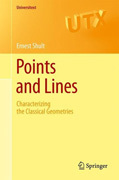
The classical geometries of points and lines include not only the projective and polar spaces, but similar truncations of geometries naturally arising fromthe groups of Lie type. Virtually all of these geometries (or homomorphic images of them) are characterized in this book by simple local axioms on points and lines. Simple point-line characterizations of Lie incidence geometries allow one to recognize Lie incidence geometries and their automorphism groups. These tools could be useful in shortening the enormously lengthy classification of finite simple groups. Similarly, recognizing ruled manifolds by axioms on light trajectories, offers a way for a physicist to recognize the action of a Lie group in a context where it is not clear what Hamiltonians or Casimir operators are involved. The presentation is self-contained in the sense that proofs proceed step-by-step from elementary first principals without further appeal to outside results. Several chapters have new heretofore unpublished research results. On the other hand, certain groups of chapters would make good graduatecourses. All but one chapter provide exercises for either use in such a course, or to elicit new research directions. Contains theorems characterizing the classical projective spaces, polar spaces and geometries of exceptional Lie groups, which are combined with proofs in one source Contains an entirely new treatment of buildings Students can follow all the proofs from elementary first principles without any appeal to external publications INDICE: I.Basics.- 1 Basics about Graphs.- 2 .Geometries: Basic Concepts.-3 .Point-line Geometries.-4.Hyperplanes, Embeddings and Teirlinck's Eheory.- II.The Classical Geometries.- 5 .Projective Planes.-6.Projective Spaces.- 7.Polar Spaces.- 8.Near Polygons.- III.Methodology.- 9.Chamber Systems and Buildings.- 10.2-Covers of Chamber Systems.- 11.Locally Truncated Diagram Geometries.-12.Separated Systems of Singular Spaces.- 13 Cooperstein's Theory of Symplecta and Parapolar Spaces.- IV.Applications to Other Lie Incidence Geometries.- 15.Characterizing the Classical Strong Parapolar Spaces: The Cohen-Cooperstein Theory Revisited.- 16.Characterizing Strong Parapolar Spaces by the Relation between Points and Certain Maximal Singular Subspaces.- 17.Point-line Characterizations of the “Long Root Geometries”.- 18.The Peculiar Pentagon Property.
- ISBN: 978-3-642-15626-7
- Editorial: Springer
- Encuadernacion: Rústica
- Páginas: 838
- Fecha Publicación: 01/12/2010
- Nº Volúmenes: 1
- Idioma: Inglés
